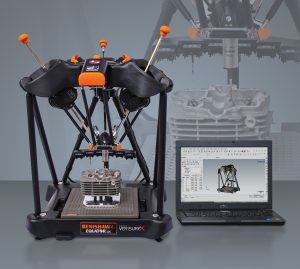Connect Education with Job Opportunities
Today, two-thirds of manufacturing companies report a moderate to severe shortage of available, qualified workers, with as many as 5% of current jobs going unfilled due to a lack of capable candidates-this represents 600,000 jobs.
One technical job area that has been contributing to the problem and opportunity is dimensional metrology, the science of length, size and dimension measurement in 2D and 3D real-world and digital space in order to compare, analyze and verify the real physical part to the original CAD model of the part.
Over the last two decades, dimensional metrology technicians have been in high demand, with the trend line growing exponentially higher. This is due to the adoption of Model-Based Enterprise (MBE) strategies and processes by tier-one aerospace entities including DOD, NASA, Boeing, Northrop, Lockheed and others.
At the heart of the MBE is the CAD model; it is the absolute authority to define a part or entire product. The core of part definition is Model Based Definition (MBD), which is defined by having an unambiguously defined 3D data set, including all necessary GD&T annotations. This ensures the 3D CAD model contains all the information to define a part or product. Inspection, measurement, analysis, build and reverse engineering are activities that utilize MBD features for parts and sub-assemblies which are built, then verified using an MBD quality inspection process. MBD is the undisputed source of definition.
This process eliminates the expense and time-consuming process of mock-ups, as interoperability, manufacturability, and interference fits are all sorted out prior to the first actual manufacturing process taking place.
“There is unlimited opportunity for re-use of CAD data when product design intent is captured digitally and the digital thread is maintained. Digital data sets must be accurate, consumable by software, and support direct manufacture from 3D geometry,” said Jennifer Herron, CEO of Action Engineering and author of Re-Use Your CAD.
“In order to ‘Re-Use Your CAD’ and take advantage of MBD inspection and measurement opportunities, she said, “you must first create 3D models that are compliant with standard modeling practices and meet ASME and ISO requirements.”
Whereas manufacturing and quality assurance uses 3D MBD for inspection and validation, MBE serves as the authoritative information source for all activities in the product’s lifecycle. The four technical thrust areas are Product Lifecycle Management Integration, Model-Based Systems Engineering, Model-Based Manufacturing, and Model-Based Work Instructions.
All future large scale manufacturing operations will be MBE which is the future state of manufacturing. The practice of using 3D models and Technical Data Packages as a single source model throughout the lifecycle of a product is quickly becoming common practice. It provides a reference source to base funding and training decisions on. MBE is an integrated and collaborative environment, founded on 3D MBD, shared across the enterprise, enabling rapid, seamless, and affordable deployment of products from concept to disposal. It represents a fundamental shift from 20 to 30 or from physical drawings to virtual models.
Maintaining The Digital Thread
Reverse Engineering – The digital thread of a product begins in reverse engineering physical parts to CAD. This has become increasingly prevalent in design and engineering workflow today as features from legacy parts without available CAD data, or organic or other complex surface profiles are incorporated into current designs. Though reverse engineering applications can differ vastly they all have one thing in common: the need to capture highly accurate surface points and reverse engineer them back into 30 CAD models for manufacturing and inspection. Reverse engineering requires a specialized skill-set and comprehensive understanding of dimensional metrology.
The new Digital Thread in advanced manufacturing now incorporates inspection, measurement, and verification, requiring skilled workers.
Part Validation – As the part moves through the traditional CAD, CAE and CAM process the digital thread remains intact. Once a prototype or first article part is completed the digital thread must be extended to include part validation. That is to compare and analyze the actual physical part to the digital CAD Model. This is the task of dimensional metrology inspectors conducting quality assurance roles.
Specialized skill-sets are required for quality control and quality assurance measurement and inspection tasks incorporating phases of AS9100 and IS09000. These skill sets dovetail with technical abilities to operate three-, five-, six- and seven-axis Coordinate Measurement Systems (CMMs). Conformance and related documentation with open communication for technical coordination enable the processes to flow smoothly along the digital thread to product acceptance.
The dimensional metrology skill-gap is one of the many in today’s manufacturing environment. When referring to Boeing’s D6-51991 specification found on-line, the term MBD is a subset to Boeing’s DPD-Digital Product Definition-which is required by all suppliers in the Boeing supply chain. This same methodology may apply to multiple industries, aerospace, automotive, energy, marine and medical to name a few.
Closing the Skills Gap
There is a clear and present need to educate and train both at the company and individual level, concepts, processes and tools associated with dimensional metrology, also known as measurement science. Case in point: typically tier-one aerospace companies do not train suppliers in Dimensional Metrology, however, they do hold vendors accountable for its effective implementation and utilization. New methodologies, concepts and skill sets must be learned and applied. Measurement science is both art and science blended with core skills as computing power and advanced devices continue to increase the throughput speed of productivity.
Many educational institutions with industrial technology programs incorporate three of four major components-Design, Engineering, and Machine Tooling. However, Quality Assurance and Quality Control with emphasis on measurement science often have not been included or expanded sufficiently to complete the educational loop for industrial technology.
Demand is high. Educational opportunities are limited and technical abilities are demanding. Manufacturer’s today are calling for greater educational opportunities to supply them with skilled technicians. To close the digital loop, increased technical education programs are encouraged to close the skills gap manufacturers experience on a daily basis.
The need for local and regional programs providing Model-Based Definition inspection and measurement is urgent and continuous. There is a rising demand for a skilled workforce from OEMs and lower-tier suppliers. In response, Verisurf Software has entered into collaborative agreements with educational institutions, providing curriculum and equipment for instructor-led classroom-based lab and lecture coursework with hands-on how-to methodologies, online training with certification courses, classroom training aids and MBD software to strengthen the fundamental skill sets for today’s manufacturers.
Verisurf offers dedicated resources to work directly with teaching institutions, helping them to develop and implement successful Dimensional Metrology/Measurement Science course offerings.

Ray Elledge
Director of Education
Verisurf Software, Inc.
Verisurf Software, Inc.
Verisurf Software, Inc. is an advanced three-dimensional measurement solutions company committed to delivering advanced computer-aided inspection and reverse engineering solutions. Verisurf software helps manufacturers of all sizes and industries produce higher quality products in less time and at a lower cost with automated, Model-Based Inspection processes. For more information, visit the Verisurf website at https://verisurf.com.


